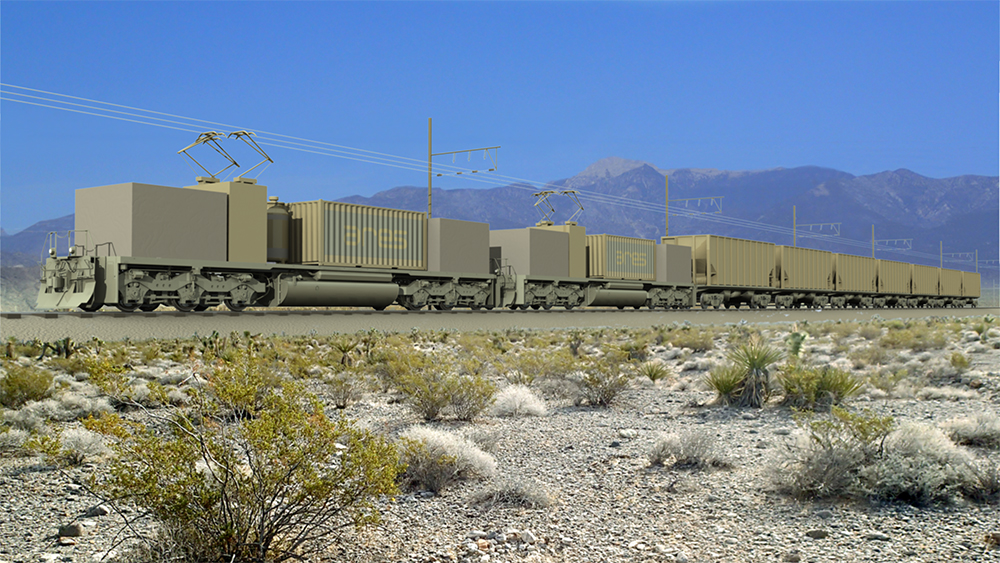
by Dan Schippers | Apr 18, 2017 | News and Events
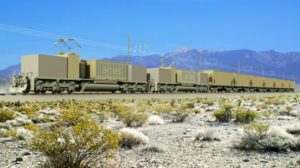
Solar Power Trains. It sounds like something you might get from a toy store, right? Well, you can’t get this from the mall, but I assure you they are cooler than any gadget you can find at the Sharper Image.
These power trains are not the same as electric trains or rail cars that run on electricity. Instead, they actually make power! They use the same principle as many hybrid cars do today, regenerative braking. Regenerative braking pairs with with gravity to create the power. This is the process of taking kinetic energy created by slowing the car or object, and converting it to electricity for use or for storage.
It works like this: during the night or when power use is low, the train will work its way up the mountain. Then, when power demand is high, the train will gradually roll back down the hill, creating on-demand electricity when it’s needed the most.
This concept of on-demand power for peak times has been around for a long time. In many parts of the country, we pump water to a high elevation reservoir and then let it flow back down through a turbine. However these trains have a leg up because they have a better response time for producing on-demand energy. This quicker response is only rivaled by batteries — which, by the way, the train is packed full of!
The first of its kind is being built in Nevada and will have the capability of producing 50 Mega Watts of power. Named ARES, or Advanced Rail Energy Storage, it will work over a 5.5-mile stretch known as the “Sisyphus Railroad.”
This is just one extraordinary example of what can be done with a combination of renewable energy power sources and battery energy storage. As we like to say at Sunbright Solar, the Future is Bright! Want to be part of the clean energy revolution, yourself? Give Sunbright Solar a call anytime — (520) 235-8133
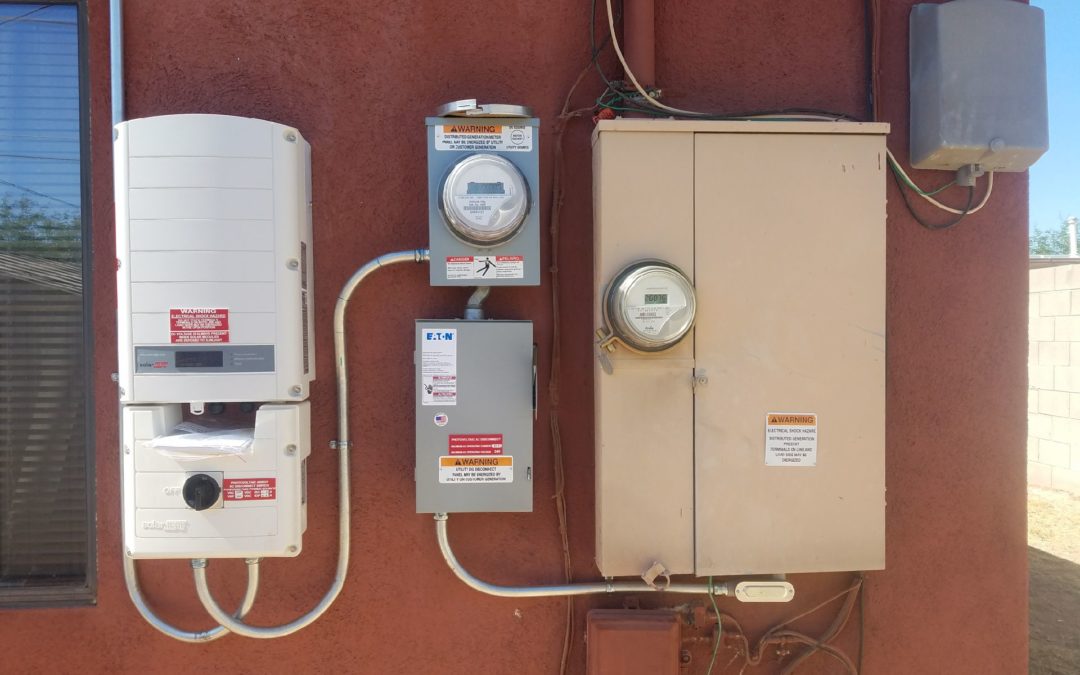
by Dan Schippers | Apr 13, 2017 | News and Events
Have you ever heard of such a thing? A “Negawatt” is the power we don’t use, but could be saved. It is real power that was generated, but never made its way home. It was simply lost in transmission…
Here’s how this happened: you see, we built our power grid on large, centralized power plants. If we needed more power, we built another plant. Then we built them bigger, made them further away, sometimes made them nuclear, and then followed that up with miles and miles of transmission lines. After all, nobody really wanted them in their backyard, and who can blame them? This was the norm, and at the time when most power was generated from coal and oil, it made sense.
However, today’s energy looks very different. We emphasize grid reliability and efficiency. We look to control rising costs at a time when demands have become greater. New generations are more and more plugged in through technology advancements, we power nearly every structure we build, and it’s looking like cars are up next.
So what does that have to do with a Negawatt? Well, for every mile electricity has to travel we get a little less out of it. So if we generate power close to home, we get more out of it. When we expand our grid with solar and wind, we get a more efficient and reliable power infrastructure. Power companies love this. They get to sell nearly 100% of your excess power to your neighbors at full cost and you get credit for future use. This concept might be a little crazy, but this is a real thing. It’s called net metering and it works like this: You add solar panels, pay a connection fee and taxes to the utility, and both you and the power company benefit from kicking the Negawatt! Try it…… You’ll save you Gigabucks! Want to learn more? Call Sunbright Solar Today! (520) 222-9993
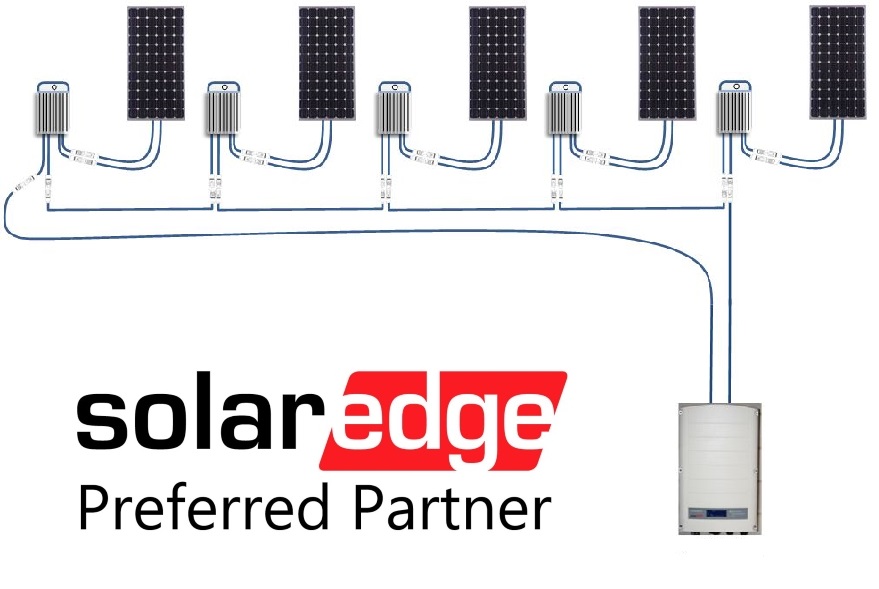
by Dan Schippers | Jan 26, 2017 | News and Events
What are MLPE’s? Let’s start with a brief history.
At the beginning of widespread solar power adoption, there were two elements in a system: panels and string inverters. Panels were simply wired together to create an array. (more…)
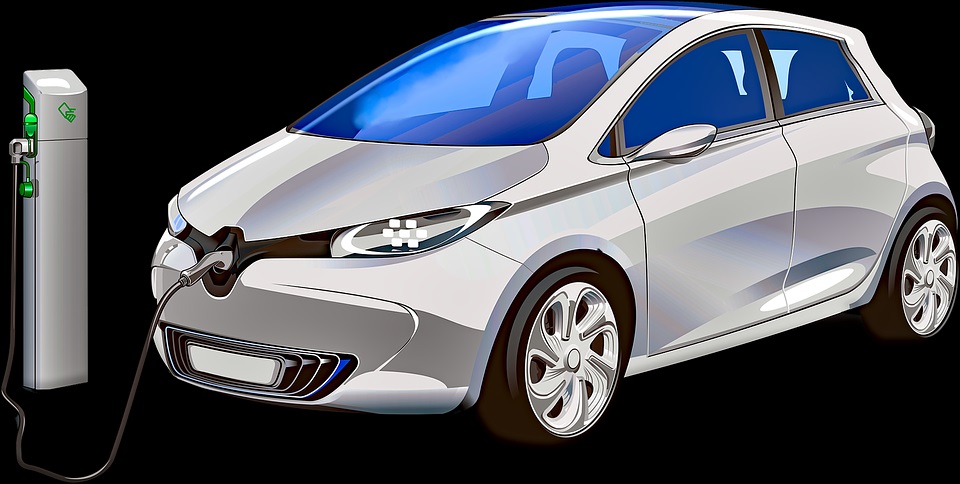
by Dan Schippers | Jan 26, 2017 | News and Events
Have you ever seen a solar-powered car? Me too…they do that race once a year where they see who can travel the fastest, “albeit at 20 mph,” called the American Solar Challenge. I hear the University of Michigan is pretty dominant. Now have you ever seen a solar-powered air conditioner? They exist, but are uncommon and don’t have a big payoff. The real point is, “Why don’t we see them more?” and “Why haven’t we seen solar AC?” Well, it’s the same reason we don’t see solar refrigerators: It’s not practical!
Why not?
Well, solar power is meant to be harnessed and released like with a battery or utility grid. Think of it this way: We can’t guarantee a sunny day tomorrow, but where I live in Tucson, Arizona, we can guarantee about 200 of them a year. The most practical solution is to connect a big solar array to the home and to the grid, thus creating solar AC’s, solar refrigerators, and more importantly Solar Electric Cars. Once you see it through that lens we start seeing a lot more solar cars than we used to. Now I think that’s pretty cool in and of itself, but really that’s just the tip of the iceberg. This image below is of a window sticker from an EV Electric Vehicle. Note that in the acronym ‘MPGe,’ (e) is for equivalent.
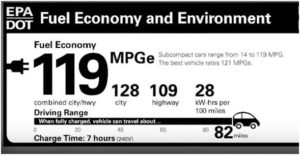
It gives you a pretty good idea of the benefits that electricity has over gas power engines when it comes to efficiency, but since we’re on the topic, let’s put some dollar figures to this.
In a typical car or SUV these days, I’d say it’s fair to say we’re getting about 20 mpg or 5 gallons per 100 miles. Last time I filled up, gas was about 2.15 a gallon, making that 100-mile trek cost about $10.75 a pop. Now the average American drives 13,476 miles a year, leaving you with a yearly tab of $1448.67. Reduce the MPG to 15, and it’s $1931. But for argument’s sake, I’d say that about $1500 is probably low but a good round number.
Now let’s Look at the EV, (I think we’re looking at info from a Nissan Leaf). It says in order to travel 100 miles, it takes 28KW-hrs. Well, a kWh, or kilowatt-hour, costs about 11 – 15 cents depending on who your utility provider is. So, if we use 12 cents then 28X$.12= $3.36 per 100 miles and $452 per year.
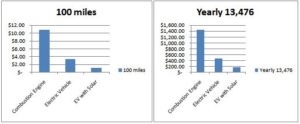
Now let’s add solar into this equation. We know that utility power is 12 to 15 cents per kWh but solar allows for power to sold or produced at a much lower costs sometimes in the range of 3-5 cents per kWh. Thus making that 100-mile trip cost right about $1.12 using 4 cent average with an annual cost of about $151 and that is why I anticipate seeing a lot more solar-powered cars in the future. Who knows I might just see you in one.
Want to know more? Check this out! Want to check out going solar with an EV-ready Inverter? Call Sunbright Solar Today! — (520) 222-9993

by Dan Schippers | Jan 1, 2017 | News and Events
Solar Technology is always growing and improving — that’s why panel prices have dropped 99% in the four decades since they were introduced! Here’s a look at some of the big trends dominating the solar industry:
1. Batteries will boom.
That’s in a good way of course. Last year tons of new companies entered the battery game. Prices are falling, batteries are becoming bigger, more powerful, and longer-lasting. The technology behind them is also keeping pace. Home battery backups can now supply automatic power in an electrical outage, eliminate demand charges from utilities, and make sure critical loads like internet servers never go down due to power loss. Even the big utility companies will be buying into batteries!
2. Panel efficiencies will continue to go up…. and up… and up!
As with the trend of manufacturers of panels and equipment makers trying to gain an edge we will see small but measurable gains in the performance department. This means that the same square ft of roof space just became that much more powerful. How much do you ask? It’s about 5% on the average system.
3. Individual Monitoring will improve
Solar monitoring platforms have become much more intuitive, reliable, and user-friendly in recent years. You can now monitor your system from your phone, computer, display kiosk, and even set the display as the background of your desktop. These platforms now let you monitor each panel’s power production independently. Meaning you can spot a problem much more quickly, diagnose, and address performance issues in ways that were unheard of years ago. Now the dealer contacts you if an issue arises. The software can be upgraded via wifi so existing solar customers can reap the benefits as they come through as well.
4. Politically and regulatory-wise, change occurs — but system profitability remains solidly in the picture
As the new administration was taking office many news articles were flying around the internet predicting all types and ranges of drama that could happen. But we pretty much already have our answer. No changes appear to be on the political agenda in regards to solar and wind specifically. Now regulatory is another story. In Arizona, the new corporation commission voted to end net-metering as we know it. While this sounds like bad news, allow me to point out the silver linings. The new form of metering replacing net-metering will not be as devastating as some would like to think. It will provide us the platform for how solar will work with the utilities for many years to come. It is still worthwhile to go solar and you can reap the benefits of solar with the new metering platform!
SUNBRIGHT SOLAR UPDATE: TEP (Tucson Electric Power) updated to an Export Rate system in September of 2018. Export-rate users continue to benefit from saving money month over month; and TEP users in particular enjoy advantageous purchase rate from TEP for their excess power.
5. Aesthetically-integrated solar will start to show up.
In recent years we’ve seen an explosion in solar shade structures. Whether it is a shady spot to park your vehicles or to provide covered seating, everyone can see the added benefits of a shade structure. In 2017 we will start to see some innovative designs. Panels can be transparent on the back, and the structures will evolve from the industrial-steel look to works of modern architectural wonders.









Recent Comments